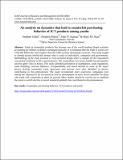An analysis on dynamics that lead to counterfeit purchasing behavior of ICT products among youths

View/
Date
2014Author
Githii, Stephen
Maina, Stephen
Kamau, John N.
Njau, Mary M.
Type
ArticleLanguage
enMetadata
Show full item recordAbstract
Trade in counterfeit products has become one of the world leading illegal activities
accounting for billions of dollars exchanged annually. It is estimated that the trade is worth over
USD 600 billion far much higher than the GDP of many developing countries. This study sought
to identify factors behind this menace that is costly to individuals, compan ies and governments.
Methodology of the study involved a cross-sectional design where a sample of 142 respondents
was picked randomly to fill a questionnaire. The respondents were from middle-income families
and the upper class in Kenya. This study identified perception of youthfulness, weak regulations,
weak branding, external influence, irresponsibility and moral decline as some of the major
factors driving counterfeit trade. Ignorance and poverty were also identified as factors
contributing to this phenomenon. The study recommends more awareness campaigns even
among the educated to be increased as well as development of more severe penalties on those
who trade with counterfeit to deter its growth. More studies should be carried out to establish
the extent to which decline in moral standards globally has contributed to this phenomenon.
URI
http://iosrjournals.org/iosr-jbm/papers/Vol16-issue8/Version-4/C016842129.pdfhttp://www.iosrjournals.org/iosr-jbm/pages/20(8)Version-6.html
http://hdl.handle.net/123456789/440
Publisher
OSR Journals International Organization of Scientific Research
ISSN
2319-76682278-487X
